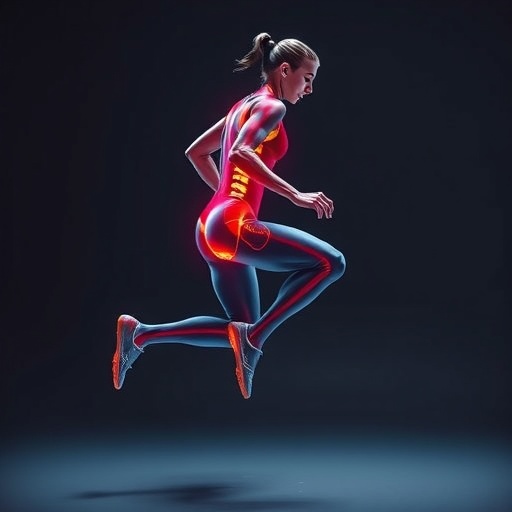In the world of sports science, the ability to accurately assess and improve athletic performance is paramount. A recent study conducted by researchers Parr, Mehmeti, and Reed has explored a novel approach to classifying proper countermovement jumps using a sacral-mounted inertial measurement unit (IMU). This innovative methodology offers insights into mechanics that could significantly enhance training processes and reduce injury risks for athletes.
Countermovement jumps, integral to many sports, require athletes to demonstrate explosive force and agility. By employing a sacral-mounted IMU, the researchers have developed a system that quantifies the biomechanics during these jumps with unprecedented accuracy. Traditionally, performance assessments in sports have relied heavily on visual observations or external incentives that often lead to subjective interpretations. This new approach aims to eliminate ambiguity by utilizing a sophisticated technology that provides real-time feedback on an athlete’s performance.
The sacral-mounted IMU captures critical data points such as acceleration and orientation throughout the jump cycle. By analyzing this data, the team was able to categorize jumps into defined classifications, enabling coaches and trainers to tailor their training regimens precisely to the athlete’s needs. This level of granularity in data collection is groundbreaking, as it allows for individualized feedback that can optimize training outcomes.
Incorporating advanced technology like the sacral-mounted IMU represents a shift in how coaches and sports scientists view performance monitoring. Instead of relying solely on traditional metrics such as jump height, this study highlights the importance of understanding the dynamics of movement. The classification of jumps based on motion patterns leads to a deeper comprehension of an athlete’s biomechanics and can help identify areas for improvement, thereby enhancing overall performance.
One particularly significant finding from this research is the correlation between jump mechanics and injury prevention. By quantifying jump performance and identifying improper techniques, trainers can intervene earlier, offering corrective training that may prevent potential injuries. For many athletes, especially at the elite level, the prevalence of injuries can severely hinder their careers. This proactive approach to injury prevention may change the landscape of athlete management in high-performance sports.
Additionally, the study emphasizes the practicality of the sacral-mounted IMU. The design is engineered to be unobtrusive, minimizing any potential interference with the athlete’s performance while capturing crucial data. This feature allows athletes to perform as they normally would, providing a more accurate representation of their capabilities. Traditional measurement tools can often alter an athlete’s performance due to discomfort or distraction; however, the IMU’s design mitigates these concerns.
The implications of this research extend beyond just performance enhancement. It democratizes access to high-level analytics for a broader range of athletes, from professionals to amateurs. As sports technology continues to evolve, tools that were once reserved for elite athletes are now becoming accessible to the general public, ensuring that an increasing number of individuals can benefit from data-driven insights.
Furthermore, the findings encourage a reevaluation of how coaches apply training methodologies. With the ability to classify and analyze jumps, coaches are now equipped with more than just anecdotal evidence; they possess quantitative data that can direct training decisions. This transformative approach can lead to success on the field, reducing trial-and-error periods typically associated with coaching decisions.
The research demonstrates robust methodologies that highlight the potential of wearable technology in sports analytics. While the IMU is just one example, it opens the door to a variety of tools that can be integrated into training regimens. The adaptability of such technology means ongoing improvements in understanding athlete performance will continue to emerge, paving the way for innovative solutions addressing diverse athletic challenges.
As sports science continues to progress, the classification of countermovement jumps through sophisticated measurement tools represents an intersection of technology and athletic performance. The researchers involved in the study envision a future where data is seamlessly integrated into training plans, transforming the way athletes train and compete. For coaches and trainers, the ability to leverage this information will undoubtedly refine their strategies and promote a data-centric culture in athletics.
Looking ahead, the researchers anticipate that subsequent studies will explore even more advanced applications of this wearable technology. This could involve merging the IMU data with other physiological metrics, leading to comprehensive performance profiles. Such integration promises even deeper insights into the multifaceted nature of athletic capabilities, potentially unlocking new paradigms in sports performance.
In conclusion, the classification of countermovement jumps through sacral-mounted IMUs represents a groundbreaking development in the analysis of athletic performance. By adopting a scientific approach to biomechanics, this research not only provides an avenue for enhancing training efficiency but also fosters a proactive stance on injury prevention. These advancements underscore the necessity of embracing technology in evolving sports science, promising a future where athletes achieve their pinnacle performance while diminishing the risk of injury.
As this research gains traction, we can anticipate broader discussions in the field about the role of technology in sports. The fusion of biomechanics with user-friendly applications is likely to be a focal point in coming years, guiding the efforts to push athletic performance to new heights.
Subject of Research: Classification of proper countermovement jumps using a sacral-mounted inertial measurement unit.
Article Title: Classification of proper countermovement jumps using a sacral-mounted inertial measurement unit.
Article References:
Parr, T.E., Mehmeti, L., Reed, J. et al. Classification of proper countermovement jumps using a sacral-mounted inertial measurement unit.
Sports Eng 28, 47 (2025). https://doi.org/10.1007/s12283-025-00526-3
Image Credits: AI Generated
DOI:
Keywords: Proper countermovement jumps, inertial measurement unit, biomechanics, athletic performance, injury prevention, sports science, wearable technology.




